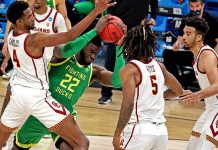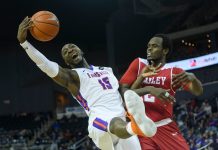A diversity report for graduation rates among potential NCAA Tournament teams found a larger gap between white and black men’s players from the previous year, while male players continue to lag behind their female counterparts overall.
The Institute for Diversity and Ethics in Sport (TIDES) at Central Florida released two annual studies this week examining graduation rates for men’s and women’s teams invited to the NCAA Tournament. With the tournament canceled amid the coronavirus pandemic, the studies used final bracket projections from ESPN as a substitute.
On the men’s side, the gap between the average Graduation Success Rate (GSR) for white and black players increased after declines in the previous two years. Scores for both groups were higher, though gains by white players outpaced those of black players to create the larger gap.
Institute director Richard Lapchick, the lead report author, called the increased gap “disappointing” and “more than discouraging” in the study.
“The good news outweighs the bad news,” Lapchick said of overall gains in an interview with The Associated Press. “The bad news means we just have to keep looking at that gap and trying to narrow it.”
The study looked primarily at the GSR, developed for the NCAA to track the progress of Division I student-athletes for six years after entering school. GSR doesn’t penalize schools for athletes who leave in good standing and counts transfers at their new schools. A federal graduation rate doesn’t factor in those common roster movements and would consider them to be non-graduates.
The difference in average GSR for white men’s players (94.3%) and black men’s players (80%) stood at 14.3 percentage points, up from 12.6 in the 2019 study. While higher, that represents significant improvement from 27 percentage points when the study began in 2006, 32 points in 2011 and 24 points as recently as 2015.
The women’s study found the difference in average GSR for white players (95.9%) and black players (89.6%) was smaller at 6.3 percentage points, falling from 7.4 the previous year. That gap was as low as 3 percentage points in 2018 but has generally bounced between 6 and 12 points for the past decade.
The overall GSR for women was 93% compared to 82.8% for the men, according to the study. Both numbers were up and the gap of 10.2 percentage points was slightly lower than 2019 (10.8).
“It’s good news that women are succeeding,” Lapchick said. “I think it’s also good news that the gap between men and women continued to improve, so that sooner or later, they’re getting closer and closer to the women. I think we are paying much more attention on college campuses across the board to the importance of the academic part of the student-athlete.”
Additionally, the study also looked at the potential impact of diversity with head coaches when it comes to players’ academic success.
The men’s study reported the average GSR for teams with a black head coach was better (84.5%) than for a team with a white head coach (82.3%). For the women, the study reported higher average GSR for teams with a woman as head coach (93.9%) than with a man (91.7%). Lapchick said in the men’s study that researchers will continue to track that in coming years.
The men’s and women’s college basketball studies are part of a series of annual reports by TIDES. Those include racial and gender hiring practices in college athletics as well as for professional leagues such as the NFL, NBA, WNBA, Major League Baseball and Major League Soccer.
—
More AP college basketball: https://apnews.com/Collegebasketball and http://www.twitter.com/AP-Top25
—
Follow Aaron Beard on Twitter at http://www.twitter.com/aaronbeardap
25% Bonus via Western Union

















